Project Report: Financial and Economic Literacy in the UK Market
VerifiedAdded on 2021/04/24
|19
|5260
|334
Project
AI Summary
This project report provides an in-depth analysis of the UK's financial and economic landscape. It begins with an examination of the UK local high street store, FarmFoods, evaluating its market structure and growth strategies. The report then delves into the demand and supply dynamics of the UK housing market, discussing the impact of economic factors and monetary policies. Key macroeconomic indicators, including GDP, employment rates, and the balance of trade, are analyzed to assess the overall economic health of the UK. The report also explores financial and accounting concepts, such as leverage and current account management, and concludes with a financial analysis of the UK market, drawing conclusions based on the research findings and supporting evidence. The report uses various articles, economic reports, and newspapers to support its analysis and conclusions.
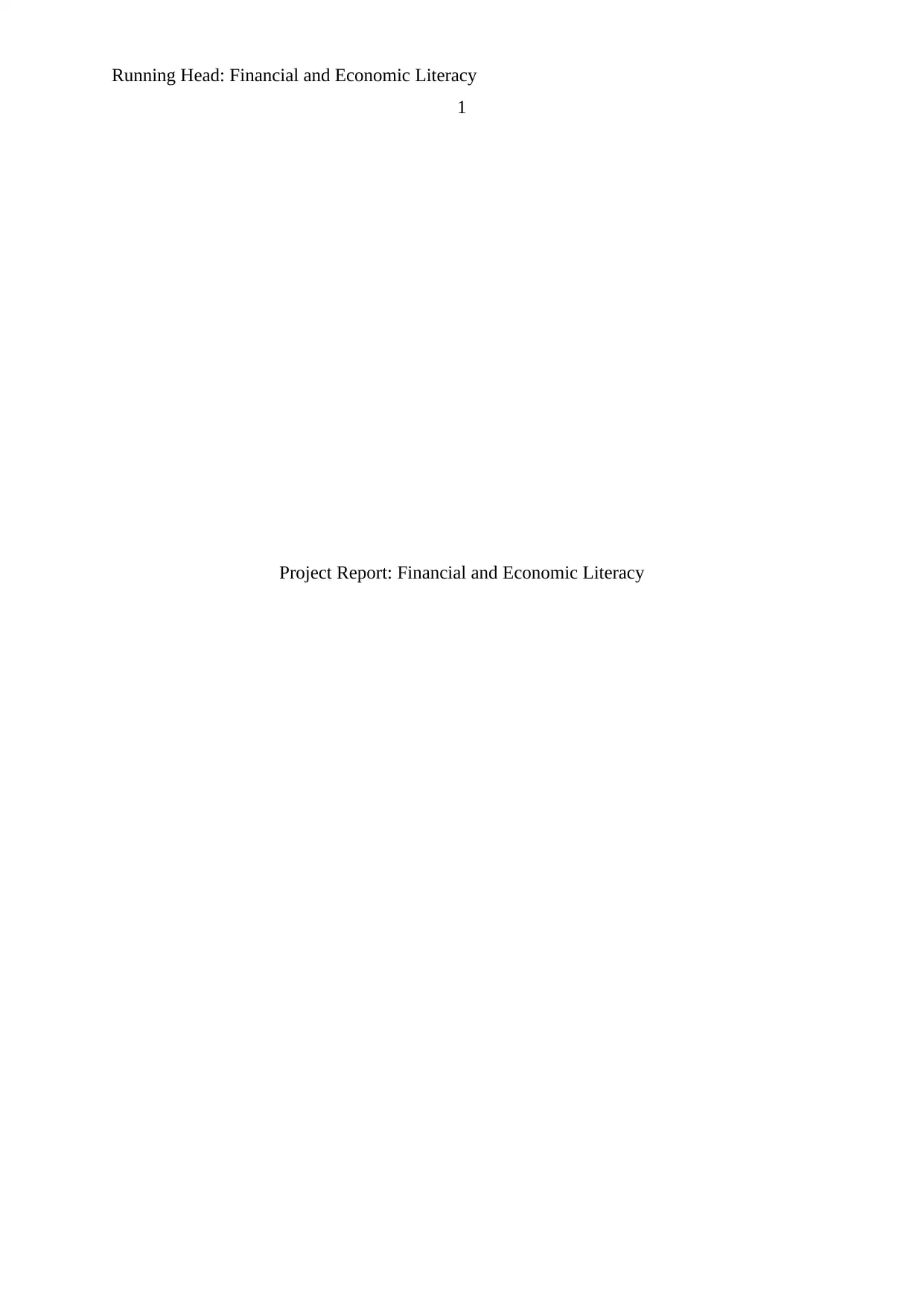
Running Head: Financial and Economic Literacy
1
Project Report: Financial and Economic Literacy
1
Project Report: Financial and Economic Literacy
Paraphrase This Document
Need a fresh take? Get an instant paraphrase of this document with our AI Paraphraser
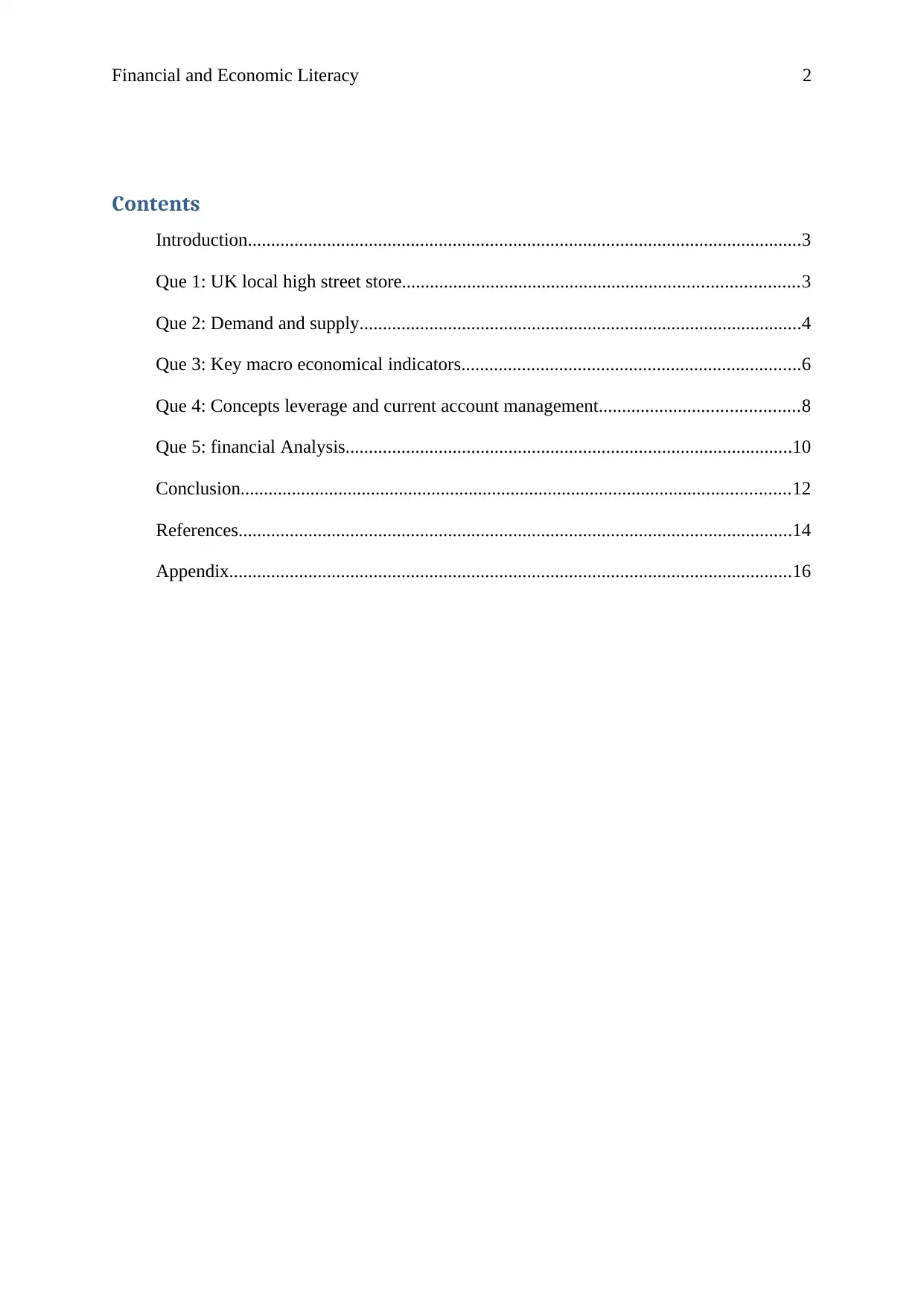
Financial and Economic Literacy 2
Contents
Introduction.......................................................................................................................3
Que 1: UK local high street store.....................................................................................3
Que 2: Demand and supply...............................................................................................4
Que 3: Key macro economical indicators.........................................................................6
Que 4: Concepts leverage and current account management...........................................8
Que 5: financial Analysis................................................................................................10
Conclusion......................................................................................................................12
References.......................................................................................................................14
Appendix.........................................................................................................................16
Contents
Introduction.......................................................................................................................3
Que 1: UK local high street store.....................................................................................3
Que 2: Demand and supply...............................................................................................4
Que 3: Key macro economical indicators.........................................................................6
Que 4: Concepts leverage and current account management...........................................8
Que 5: financial Analysis................................................................................................10
Conclusion......................................................................................................................12
References.......................................................................................................................14
Appendix.........................................................................................................................16
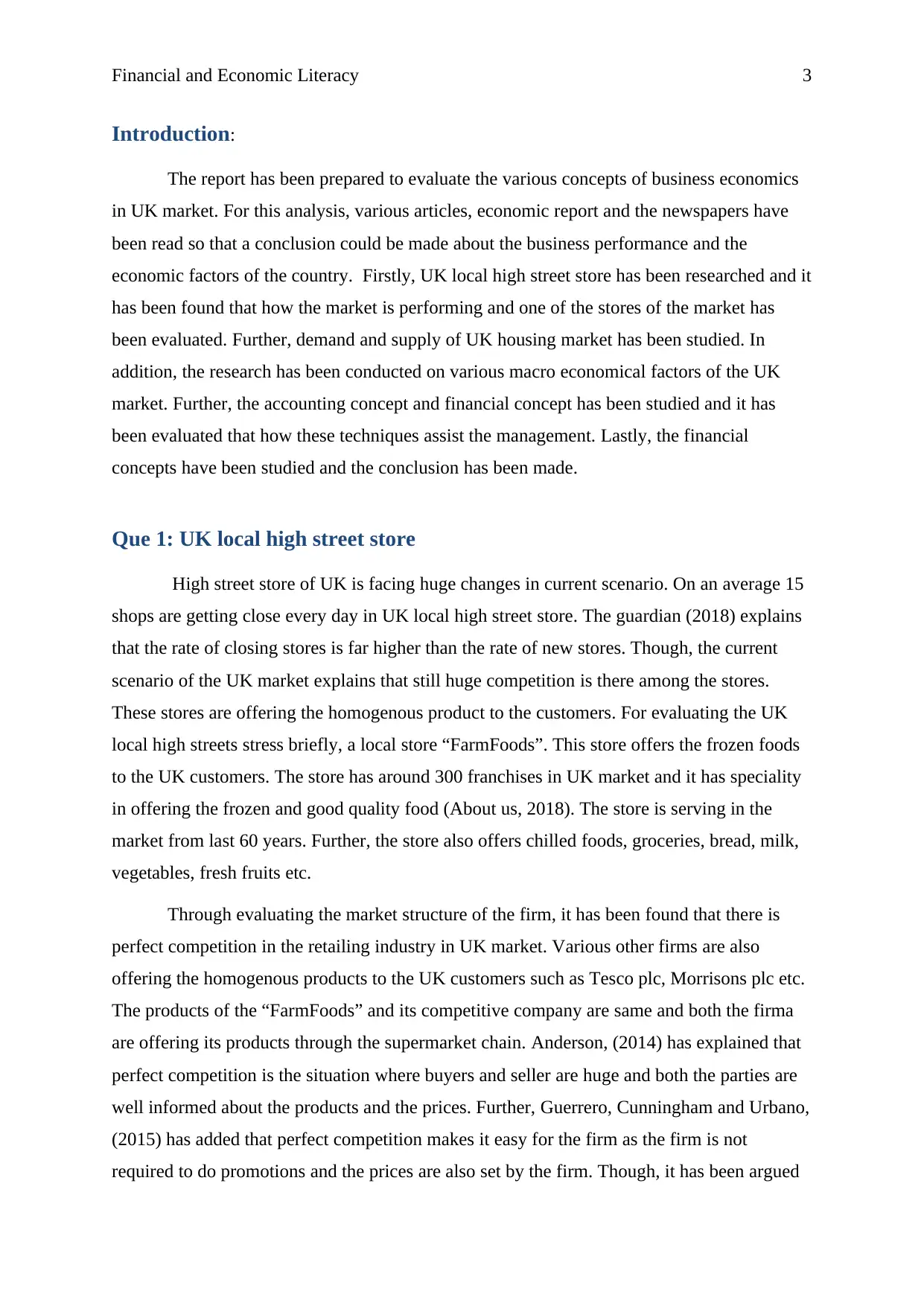
Financial and Economic Literacy 3
Introduction:
The report has been prepared to evaluate the various concepts of business economics
in UK market. For this analysis, various articles, economic report and the newspapers have
been read so that a conclusion could be made about the business performance and the
economic factors of the country. Firstly, UK local high street store has been researched and it
has been found that how the market is performing and one of the stores of the market has
been evaluated. Further, demand and supply of UK housing market has been studied. In
addition, the research has been conducted on various macro economical factors of the UK
market. Further, the accounting concept and financial concept has been studied and it has
been evaluated that how these techniques assist the management. Lastly, the financial
concepts have been studied and the conclusion has been made.
Que 1: UK local high street store
High street store of UK is facing huge changes in current scenario. On an average 15
shops are getting close every day in UK local high street store. The guardian (2018) explains
that the rate of closing stores is far higher than the rate of new stores. Though, the current
scenario of the UK market explains that still huge competition is there among the stores.
These stores are offering the homogenous product to the customers. For evaluating the UK
local high streets stress briefly, a local store “FarmFoods”. This store offers the frozen foods
to the UK customers. The store has around 300 franchises in UK market and it has speciality
in offering the frozen and good quality food (About us, 2018). The store is serving in the
market from last 60 years. Further, the store also offers chilled foods, groceries, bread, milk,
vegetables, fresh fruits etc.
Through evaluating the market structure of the firm, it has been found that there is
perfect competition in the retailing industry in UK market. Various other firms are also
offering the homogenous products to the UK customers such as Tesco plc, Morrisons plc etc.
The products of the “FarmFoods” and its competitive company are same and both the firma
are offering its products through the supermarket chain. Anderson, (2014) has explained that
perfect competition is the situation where buyers and seller are huge and both the parties are
well informed about the products and the prices. Further, Guerrero, Cunningham and Urbano,
(2015) has added that perfect competition makes it easy for the firm as the firm is not
required to do promotions and the prices are also set by the firm. Though, it has been argued
Introduction:
The report has been prepared to evaluate the various concepts of business economics
in UK market. For this analysis, various articles, economic report and the newspapers have
been read so that a conclusion could be made about the business performance and the
economic factors of the country. Firstly, UK local high street store has been researched and it
has been found that how the market is performing and one of the stores of the market has
been evaluated. Further, demand and supply of UK housing market has been studied. In
addition, the research has been conducted on various macro economical factors of the UK
market. Further, the accounting concept and financial concept has been studied and it has
been evaluated that how these techniques assist the management. Lastly, the financial
concepts have been studied and the conclusion has been made.
Que 1: UK local high street store
High street store of UK is facing huge changes in current scenario. On an average 15
shops are getting close every day in UK local high street store. The guardian (2018) explains
that the rate of closing stores is far higher than the rate of new stores. Though, the current
scenario of the UK market explains that still huge competition is there among the stores.
These stores are offering the homogenous product to the customers. For evaluating the UK
local high streets stress briefly, a local store “FarmFoods”. This store offers the frozen foods
to the UK customers. The store has around 300 franchises in UK market and it has speciality
in offering the frozen and good quality food (About us, 2018). The store is serving in the
market from last 60 years. Further, the store also offers chilled foods, groceries, bread, milk,
vegetables, fresh fruits etc.
Through evaluating the market structure of the firm, it has been found that there is
perfect competition in the retailing industry in UK market. Various other firms are also
offering the homogenous products to the UK customers such as Tesco plc, Morrisons plc etc.
The products of the “FarmFoods” and its competitive company are same and both the firma
are offering its products through the supermarket chain. Anderson, (2014) has explained that
perfect competition is the situation where buyers and seller are huge and both the parties are
well informed about the products and the prices. Further, Guerrero, Cunningham and Urbano,
(2015) has added that perfect competition makes it easy for the firm as the firm is not
required to do promotions and the prices are also set by the firm. Though, it has been argued
⊘ This is a preview!⊘
Do you want full access?
Subscribe today to unlock all pages.

Trusted by 1+ million students worldwide
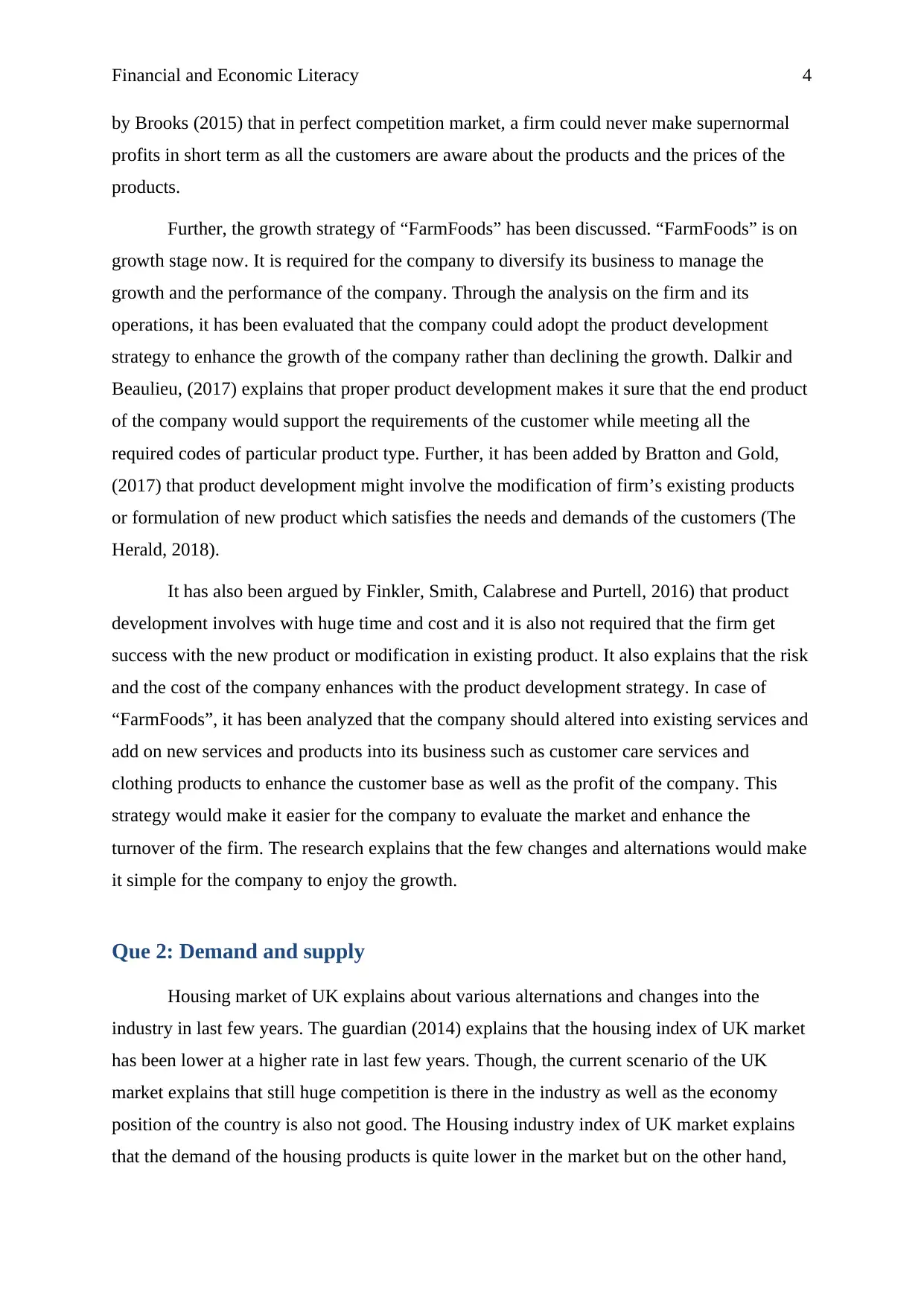
Financial and Economic Literacy 4
by Brooks (2015) that in perfect competition market, a firm could never make supernormal
profits in short term as all the customers are aware about the products and the prices of the
products.
Further, the growth strategy of “FarmFoods” has been discussed. “FarmFoods” is on
growth stage now. It is required for the company to diversify its business to manage the
growth and the performance of the company. Through the analysis on the firm and its
operations, it has been evaluated that the company could adopt the product development
strategy to enhance the growth of the company rather than declining the growth. Dalkir and
Beaulieu, (2017) explains that proper product development makes it sure that the end product
of the company would support the requirements of the customer while meeting all the
required codes of particular product type. Further, it has been added by Bratton and Gold,
(2017) that product development might involve the modification of firm’s existing products
or formulation of new product which satisfies the needs and demands of the customers (The
Herald, 2018).
It has also been argued by Finkler, Smith, Calabrese and Purtell, 2016) that product
development involves with huge time and cost and it is also not required that the firm get
success with the new product or modification in existing product. It also explains that the risk
and the cost of the company enhances with the product development strategy. In case of
“FarmFoods”, it has been analyzed that the company should altered into existing services and
add on new services and products into its business such as customer care services and
clothing products to enhance the customer base as well as the profit of the company. This
strategy would make it easier for the company to evaluate the market and enhance the
turnover of the firm. The research explains that the few changes and alternations would make
it simple for the company to enjoy the growth.
Que 2: Demand and supply
Housing market of UK explains about various alternations and changes into the
industry in last few years. The guardian (2014) explains that the housing index of UK market
has been lower at a higher rate in last few years. Though, the current scenario of the UK
market explains that still huge competition is there in the industry as well as the economy
position of the country is also not good. The Housing industry index of UK market explains
that the demand of the housing products is quite lower in the market but on the other hand,
by Brooks (2015) that in perfect competition market, a firm could never make supernormal
profits in short term as all the customers are aware about the products and the prices of the
products.
Further, the growth strategy of “FarmFoods” has been discussed. “FarmFoods” is on
growth stage now. It is required for the company to diversify its business to manage the
growth and the performance of the company. Through the analysis on the firm and its
operations, it has been evaluated that the company could adopt the product development
strategy to enhance the growth of the company rather than declining the growth. Dalkir and
Beaulieu, (2017) explains that proper product development makes it sure that the end product
of the company would support the requirements of the customer while meeting all the
required codes of particular product type. Further, it has been added by Bratton and Gold,
(2017) that product development might involve the modification of firm’s existing products
or formulation of new product which satisfies the needs and demands of the customers (The
Herald, 2018).
It has also been argued by Finkler, Smith, Calabrese and Purtell, 2016) that product
development involves with huge time and cost and it is also not required that the firm get
success with the new product or modification in existing product. It also explains that the risk
and the cost of the company enhances with the product development strategy. In case of
“FarmFoods”, it has been analyzed that the company should altered into existing services and
add on new services and products into its business such as customer care services and
clothing products to enhance the customer base as well as the profit of the company. This
strategy would make it easier for the company to evaluate the market and enhance the
turnover of the firm. The research explains that the few changes and alternations would make
it simple for the company to enjoy the growth.
Que 2: Demand and supply
Housing market of UK explains about various alternations and changes into the
industry in last few years. The guardian (2014) explains that the housing index of UK market
has been lower at a higher rate in last few years. Though, the current scenario of the UK
market explains that still huge competition is there in the industry as well as the economy
position of the country is also not good. The Housing industry index of UK market explains
that the demand of the housing products is quite lower in the market but on the other hand,
Paraphrase This Document
Need a fresh take? Get an instant paraphrase of this document with our AI Paraphraser
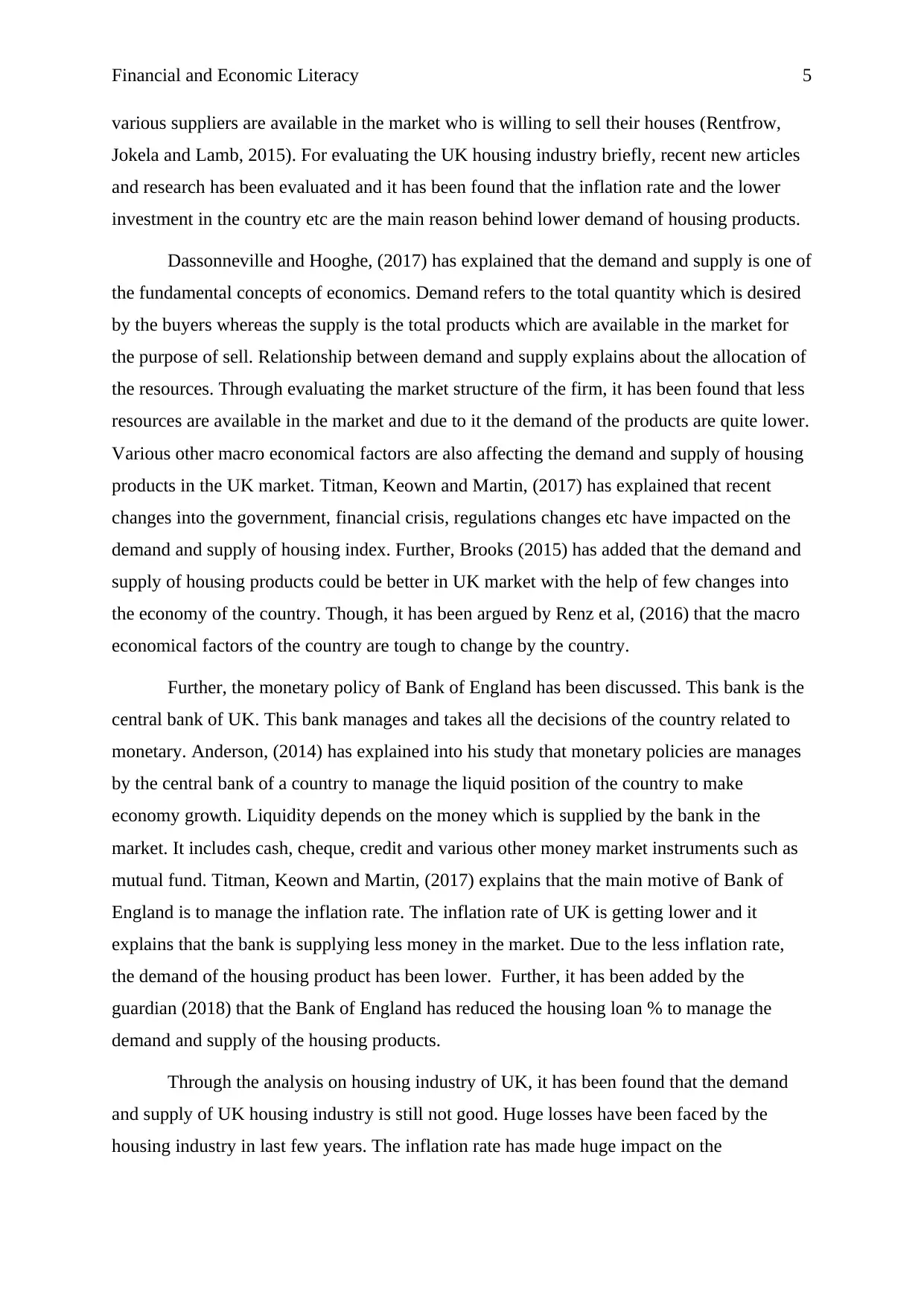
Financial and Economic Literacy 5
various suppliers are available in the market who is willing to sell their houses (Rentfrow,
Jokela and Lamb, 2015). For evaluating the UK housing industry briefly, recent new articles
and research has been evaluated and it has been found that the inflation rate and the lower
investment in the country etc are the main reason behind lower demand of housing products.
Dassonneville and Hooghe, (2017) has explained that the demand and supply is one of
the fundamental concepts of economics. Demand refers to the total quantity which is desired
by the buyers whereas the supply is the total products which are available in the market for
the purpose of sell. Relationship between demand and supply explains about the allocation of
the resources. Through evaluating the market structure of the firm, it has been found that less
resources are available in the market and due to it the demand of the products are quite lower.
Various other macro economical factors are also affecting the demand and supply of housing
products in the UK market. Titman, Keown and Martin, (2017) has explained that recent
changes into the government, financial crisis, regulations changes etc have impacted on the
demand and supply of housing index. Further, Brooks (2015) has added that the demand and
supply of housing products could be better in UK market with the help of few changes into
the economy of the country. Though, it has been argued by Renz et al, (2016) that the macro
economical factors of the country are tough to change by the country.
Further, the monetary policy of Bank of England has been discussed. This bank is the
central bank of UK. This bank manages and takes all the decisions of the country related to
monetary. Anderson, (2014) has explained into his study that monetary policies are manages
by the central bank of a country to manage the liquid position of the country to make
economy growth. Liquidity depends on the money which is supplied by the bank in the
market. It includes cash, cheque, credit and various other money market instruments such as
mutual fund. Titman, Keown and Martin, (2017) explains that the main motive of Bank of
England is to manage the inflation rate. The inflation rate of UK is getting lower and it
explains that the bank is supplying less money in the market. Due to the less inflation rate,
the demand of the housing product has been lower. Further, it has been added by the
guardian (2018) that the Bank of England has reduced the housing loan % to manage the
demand and supply of the housing products.
Through the analysis on housing industry of UK, it has been found that the demand
and supply of UK housing industry is still not good. Huge losses have been faced by the
housing industry in last few years. The inflation rate has made huge impact on the
various suppliers are available in the market who is willing to sell their houses (Rentfrow,
Jokela and Lamb, 2015). For evaluating the UK housing industry briefly, recent new articles
and research has been evaluated and it has been found that the inflation rate and the lower
investment in the country etc are the main reason behind lower demand of housing products.
Dassonneville and Hooghe, (2017) has explained that the demand and supply is one of
the fundamental concepts of economics. Demand refers to the total quantity which is desired
by the buyers whereas the supply is the total products which are available in the market for
the purpose of sell. Relationship between demand and supply explains about the allocation of
the resources. Through evaluating the market structure of the firm, it has been found that less
resources are available in the market and due to it the demand of the products are quite lower.
Various other macro economical factors are also affecting the demand and supply of housing
products in the UK market. Titman, Keown and Martin, (2017) has explained that recent
changes into the government, financial crisis, regulations changes etc have impacted on the
demand and supply of housing index. Further, Brooks (2015) has added that the demand and
supply of housing products could be better in UK market with the help of few changes into
the economy of the country. Though, it has been argued by Renz et al, (2016) that the macro
economical factors of the country are tough to change by the country.
Further, the monetary policy of Bank of England has been discussed. This bank is the
central bank of UK. This bank manages and takes all the decisions of the country related to
monetary. Anderson, (2014) has explained into his study that monetary policies are manages
by the central bank of a country to manage the liquid position of the country to make
economy growth. Liquidity depends on the money which is supplied by the bank in the
market. It includes cash, cheque, credit and various other money market instruments such as
mutual fund. Titman, Keown and Martin, (2017) explains that the main motive of Bank of
England is to manage the inflation rate. The inflation rate of UK is getting lower and it
explains that the bank is supplying less money in the market. Due to the less inflation rate,
the demand of the housing product has been lower. Further, it has been added by the
guardian (2018) that the Bank of England has reduced the housing loan % to manage the
demand and supply of the housing products.
Through the analysis on housing industry of UK, it has been found that the demand
and supply of UK housing industry is still not good. Huge losses have been faced by the
housing industry in last few years. The inflation rate has made huge impact on the
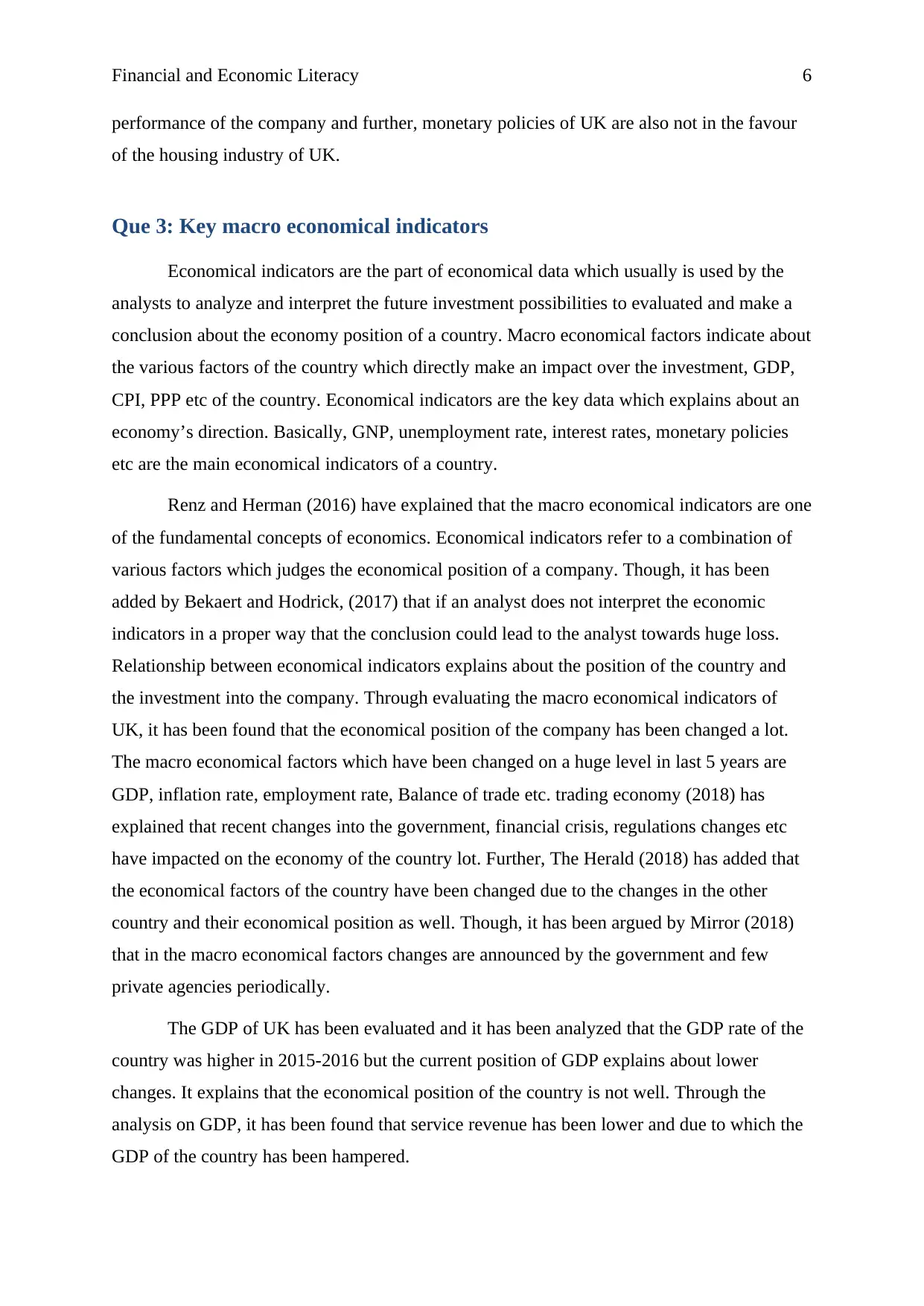
Financial and Economic Literacy 6
performance of the company and further, monetary policies of UK are also not in the favour
of the housing industry of UK.
Que 3: Key macro economical indicators
Economical indicators are the part of economical data which usually is used by the
analysts to analyze and interpret the future investment possibilities to evaluated and make a
conclusion about the economy position of a country. Macro economical factors indicate about
the various factors of the country which directly make an impact over the investment, GDP,
CPI, PPP etc of the country. Economical indicators are the key data which explains about an
economy’s direction. Basically, GNP, unemployment rate, interest rates, monetary policies
etc are the main economical indicators of a country.
Renz and Herman (2016) have explained that the macro economical indicators are one
of the fundamental concepts of economics. Economical indicators refer to a combination of
various factors which judges the economical position of a company. Though, it has been
added by Bekaert and Hodrick, (2017) that if an analyst does not interpret the economic
indicators in a proper way that the conclusion could lead to the analyst towards huge loss.
Relationship between economical indicators explains about the position of the country and
the investment into the company. Through evaluating the macro economical indicators of
UK, it has been found that the economical position of the company has been changed a lot.
The macro economical factors which have been changed on a huge level in last 5 years are
GDP, inflation rate, employment rate, Balance of trade etc. trading economy (2018) has
explained that recent changes into the government, financial crisis, regulations changes etc
have impacted on the economy of the country lot. Further, The Herald (2018) has added that
the economical factors of the country have been changed due to the changes in the other
country and their economical position as well. Though, it has been argued by Mirror (2018)
that in the macro economical factors changes are announced by the government and few
private agencies periodically.
The GDP of UK has been evaluated and it has been analyzed that the GDP rate of the
country was higher in 2015-2016 but the current position of GDP explains about lower
changes. It explains that the economical position of the country is not well. Through the
analysis on GDP, it has been found that service revenue has been lower and due to which the
GDP of the country has been hampered.
performance of the company and further, monetary policies of UK are also not in the favour
of the housing industry of UK.
Que 3: Key macro economical indicators
Economical indicators are the part of economical data which usually is used by the
analysts to analyze and interpret the future investment possibilities to evaluated and make a
conclusion about the economy position of a country. Macro economical factors indicate about
the various factors of the country which directly make an impact over the investment, GDP,
CPI, PPP etc of the country. Economical indicators are the key data which explains about an
economy’s direction. Basically, GNP, unemployment rate, interest rates, monetary policies
etc are the main economical indicators of a country.
Renz and Herman (2016) have explained that the macro economical indicators are one
of the fundamental concepts of economics. Economical indicators refer to a combination of
various factors which judges the economical position of a company. Though, it has been
added by Bekaert and Hodrick, (2017) that if an analyst does not interpret the economic
indicators in a proper way that the conclusion could lead to the analyst towards huge loss.
Relationship between economical indicators explains about the position of the country and
the investment into the company. Through evaluating the macro economical indicators of
UK, it has been found that the economical position of the company has been changed a lot.
The macro economical factors which have been changed on a huge level in last 5 years are
GDP, inflation rate, employment rate, Balance of trade etc. trading economy (2018) has
explained that recent changes into the government, financial crisis, regulations changes etc
have impacted on the economy of the country lot. Further, The Herald (2018) has added that
the economical factors of the country have been changed due to the changes in the other
country and their economical position as well. Though, it has been argued by Mirror (2018)
that in the macro economical factors changes are announced by the government and few
private agencies periodically.
The GDP of UK has been evaluated and it has been analyzed that the GDP rate of the
country was higher in 2015-2016 but the current position of GDP explains about lower
changes. It explains that the economical position of the country is not well. Through the
analysis on GDP, it has been found that service revenue has been lower and due to which the
GDP of the country has been hampered.
⊘ This is a preview!⊘
Do you want full access?
Subscribe today to unlock all pages.

Trusted by 1+ million students worldwide
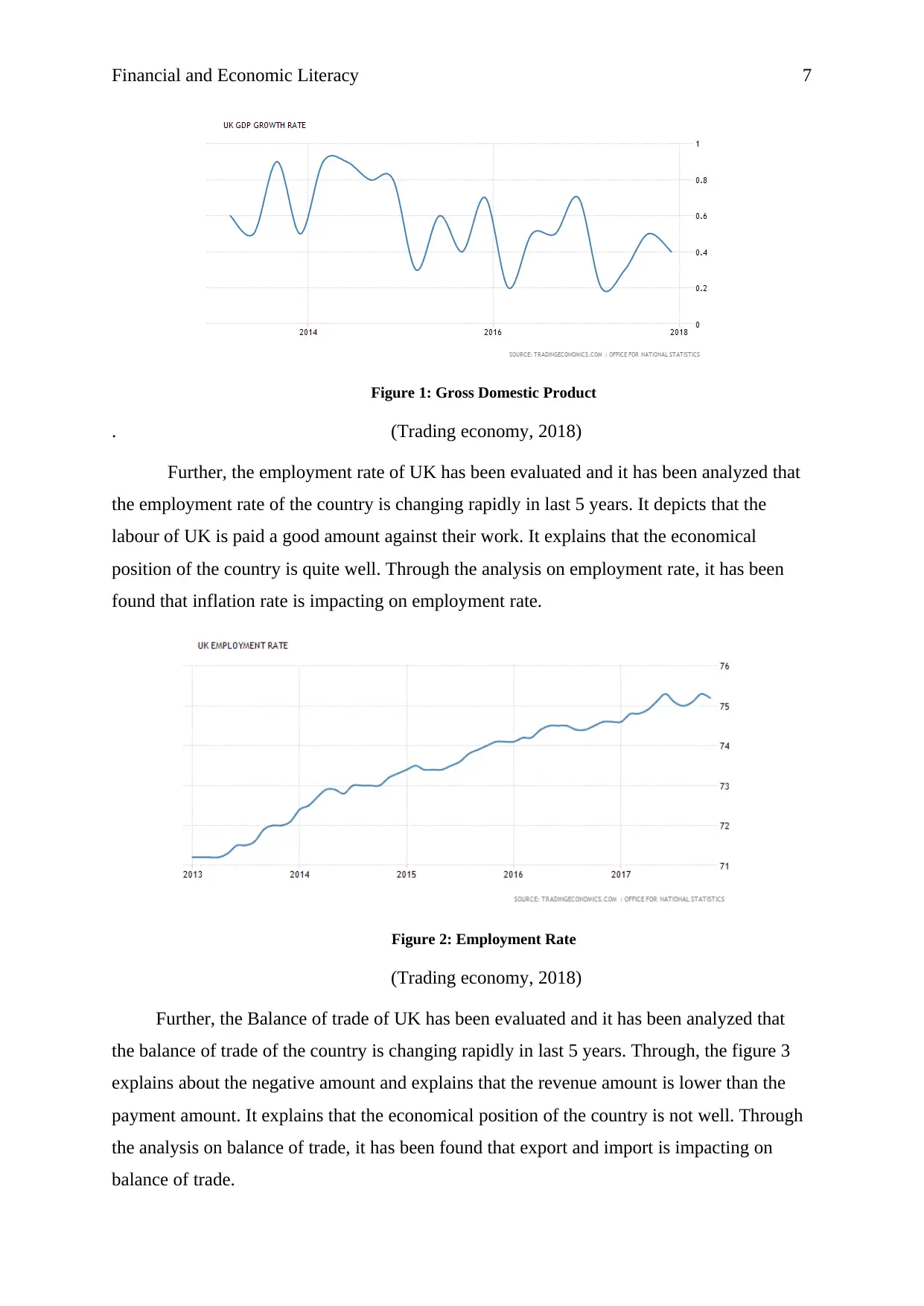
Financial and Economic Literacy 7
Figure 1: Gross Domestic Product
. (Trading economy, 2018)
Further, the employment rate of UK has been evaluated and it has been analyzed that
the employment rate of the country is changing rapidly in last 5 years. It depicts that the
labour of UK is paid a good amount against their work. It explains that the economical
position of the country is quite well. Through the analysis on employment rate, it has been
found that inflation rate is impacting on employment rate.
Figure 2: Employment Rate
(Trading economy, 2018)
Further, the Balance of trade of UK has been evaluated and it has been analyzed that
the balance of trade of the country is changing rapidly in last 5 years. Through, the figure 3
explains about the negative amount and explains that the revenue amount is lower than the
payment amount. It explains that the economical position of the country is not well. Through
the analysis on balance of trade, it has been found that export and import is impacting on
balance of trade.
Figure 1: Gross Domestic Product
. (Trading economy, 2018)
Further, the employment rate of UK has been evaluated and it has been analyzed that
the employment rate of the country is changing rapidly in last 5 years. It depicts that the
labour of UK is paid a good amount against their work. It explains that the economical
position of the country is quite well. Through the analysis on employment rate, it has been
found that inflation rate is impacting on employment rate.
Figure 2: Employment Rate
(Trading economy, 2018)
Further, the Balance of trade of UK has been evaluated and it has been analyzed that
the balance of trade of the country is changing rapidly in last 5 years. Through, the figure 3
explains about the negative amount and explains that the revenue amount is lower than the
payment amount. It explains that the economical position of the country is not well. Through
the analysis on balance of trade, it has been found that export and import is impacting on
balance of trade.
Paraphrase This Document
Need a fresh take? Get an instant paraphrase of this document with our AI Paraphraser
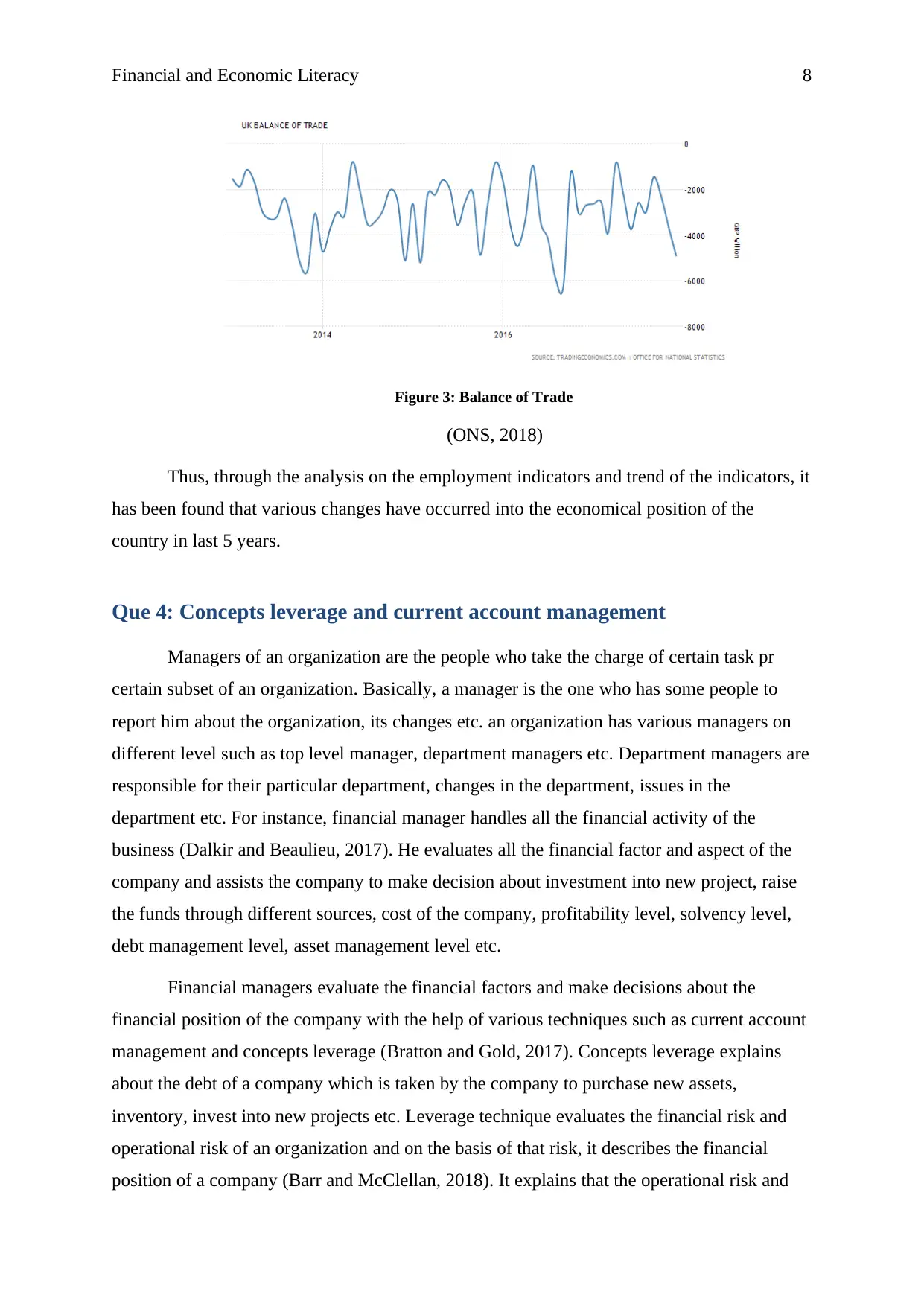
Financial and Economic Literacy 8
Figure 3: Balance of Trade
(ONS, 2018)
Thus, through the analysis on the employment indicators and trend of the indicators, it
has been found that various changes have occurred into the economical position of the
country in last 5 years.
Que 4: Concepts leverage and current account management
Managers of an organization are the people who take the charge of certain task pr
certain subset of an organization. Basically, a manager is the one who has some people to
report him about the organization, its changes etc. an organization has various managers on
different level such as top level manager, department managers etc. Department managers are
responsible for their particular department, changes in the department, issues in the
department etc. For instance, financial manager handles all the financial activity of the
business (Dalkir and Beaulieu, 2017). He evaluates all the financial factor and aspect of the
company and assists the company to make decision about investment into new project, raise
the funds through different sources, cost of the company, profitability level, solvency level,
debt management level, asset management level etc.
Financial managers evaluate the financial factors and make decisions about the
financial position of the company with the help of various techniques such as current account
management and concepts leverage (Bratton and Gold, 2017). Concepts leverage explains
about the debt of a company which is taken by the company to purchase new assets,
inventory, invest into new projects etc. Leverage technique evaluates the financial risk and
operational risk of an organization and on the basis of that risk, it describes the financial
position of a company (Barr and McClellan, 2018). It explains that the operational risk and
Figure 3: Balance of Trade
(ONS, 2018)
Thus, through the analysis on the employment indicators and trend of the indicators, it
has been found that various changes have occurred into the economical position of the
country in last 5 years.
Que 4: Concepts leverage and current account management
Managers of an organization are the people who take the charge of certain task pr
certain subset of an organization. Basically, a manager is the one who has some people to
report him about the organization, its changes etc. an organization has various managers on
different level such as top level manager, department managers etc. Department managers are
responsible for their particular department, changes in the department, issues in the
department etc. For instance, financial manager handles all the financial activity of the
business (Dalkir and Beaulieu, 2017). He evaluates all the financial factor and aspect of the
company and assists the company to make decision about investment into new project, raise
the funds through different sources, cost of the company, profitability level, solvency level,
debt management level, asset management level etc.
Financial managers evaluate the financial factors and make decisions about the
financial position of the company with the help of various techniques such as current account
management and concepts leverage (Bratton and Gold, 2017). Concepts leverage explains
about the debt of a company which is taken by the company to purchase new assets,
inventory, invest into new projects etc. Leverage technique evaluates the financial risk and
operational risk of an organization and on the basis of that risk, it describes the financial
position of a company (Barr and McClellan, 2018). It explains that the operational risk and
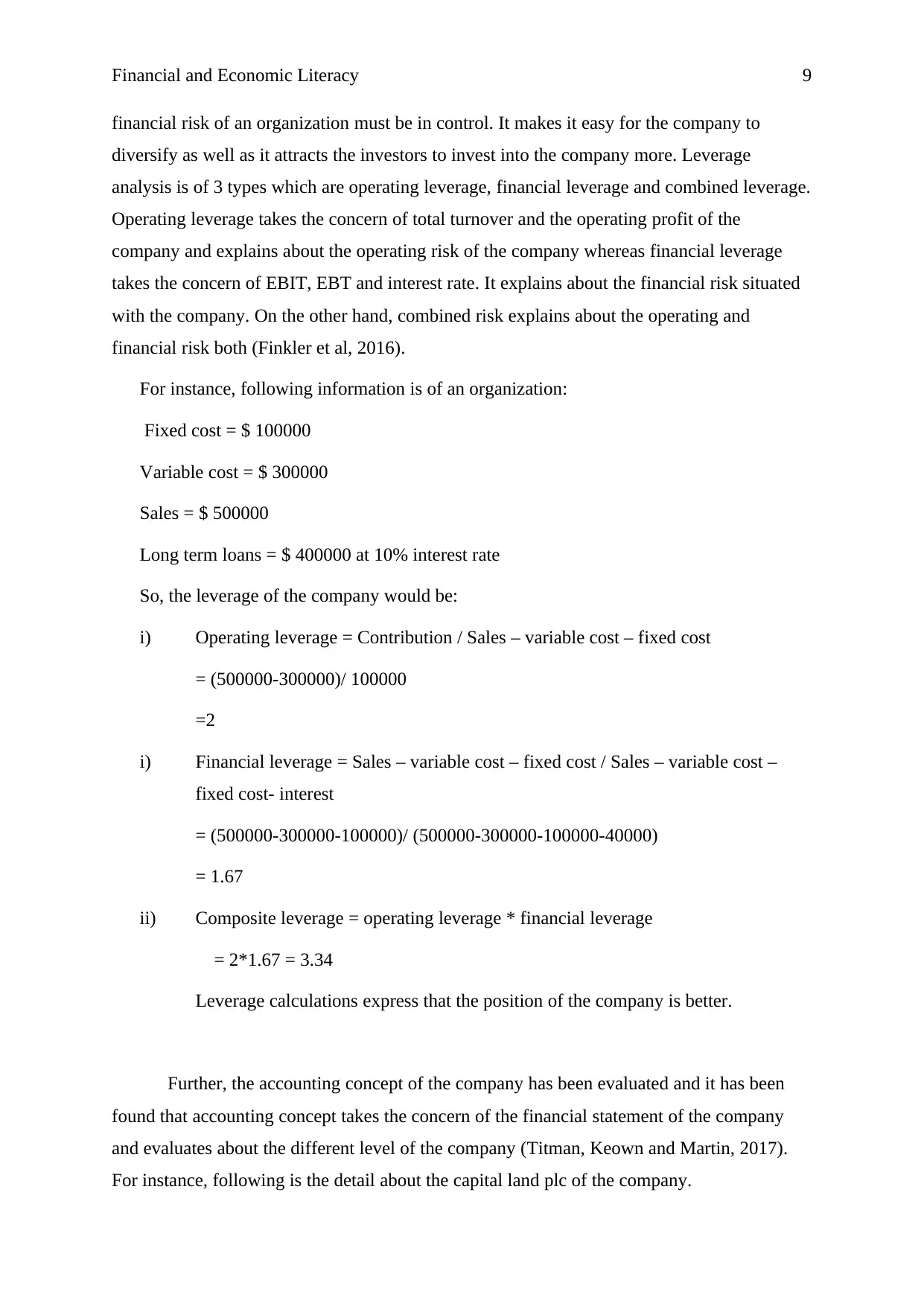
Financial and Economic Literacy 9
financial risk of an organization must be in control. It makes it easy for the company to
diversify as well as it attracts the investors to invest into the company more. Leverage
analysis is of 3 types which are operating leverage, financial leverage and combined leverage.
Operating leverage takes the concern of total turnover and the operating profit of the
company and explains about the operating risk of the company whereas financial leverage
takes the concern of EBIT, EBT and interest rate. It explains about the financial risk situated
with the company. On the other hand, combined risk explains about the operating and
financial risk both (Finkler et al, 2016).
For instance, following information is of an organization:
Fixed cost = $ 100000
Variable cost = $ 300000
Sales = $ 500000
Long term loans = $ 400000 at 10% interest rate
So, the leverage of the company would be:
i) Operating leverage = Contribution / Sales – variable cost – fixed cost
= (500000-300000)/ 100000
=2
i) Financial leverage = Sales – variable cost – fixed cost / Sales – variable cost –
fixed cost- interest
= (500000-300000-100000)/ (500000-300000-100000-40000)
= 1.67
ii) Composite leverage = operating leverage * financial leverage
= 2*1.67 = 3.34
Leverage calculations express that the position of the company is better.
Further, the accounting concept of the company has been evaluated and it has been
found that accounting concept takes the concern of the financial statement of the company
and evaluates about the different level of the company (Titman, Keown and Martin, 2017).
For instance, following is the detail about the capital land plc of the company.
financial risk of an organization must be in control. It makes it easy for the company to
diversify as well as it attracts the investors to invest into the company more. Leverage
analysis is of 3 types which are operating leverage, financial leverage and combined leverage.
Operating leverage takes the concern of total turnover and the operating profit of the
company and explains about the operating risk of the company whereas financial leverage
takes the concern of EBIT, EBT and interest rate. It explains about the financial risk situated
with the company. On the other hand, combined risk explains about the operating and
financial risk both (Finkler et al, 2016).
For instance, following information is of an organization:
Fixed cost = $ 100000
Variable cost = $ 300000
Sales = $ 500000
Long term loans = $ 400000 at 10% interest rate
So, the leverage of the company would be:
i) Operating leverage = Contribution / Sales – variable cost – fixed cost
= (500000-300000)/ 100000
=2
i) Financial leverage = Sales – variable cost – fixed cost / Sales – variable cost –
fixed cost- interest
= (500000-300000-100000)/ (500000-300000-100000-40000)
= 1.67
ii) Composite leverage = operating leverage * financial leverage
= 2*1.67 = 3.34
Leverage calculations express that the position of the company is better.
Further, the accounting concept of the company has been evaluated and it has been
found that accounting concept takes the concern of the financial statement of the company
and evaluates about the different level of the company (Titman, Keown and Martin, 2017).
For instance, following is the detail about the capital land plc of the company.
⊘ This is a preview!⊘
Do you want full access?
Subscribe today to unlock all pages.

Trusted by 1+ million students worldwide
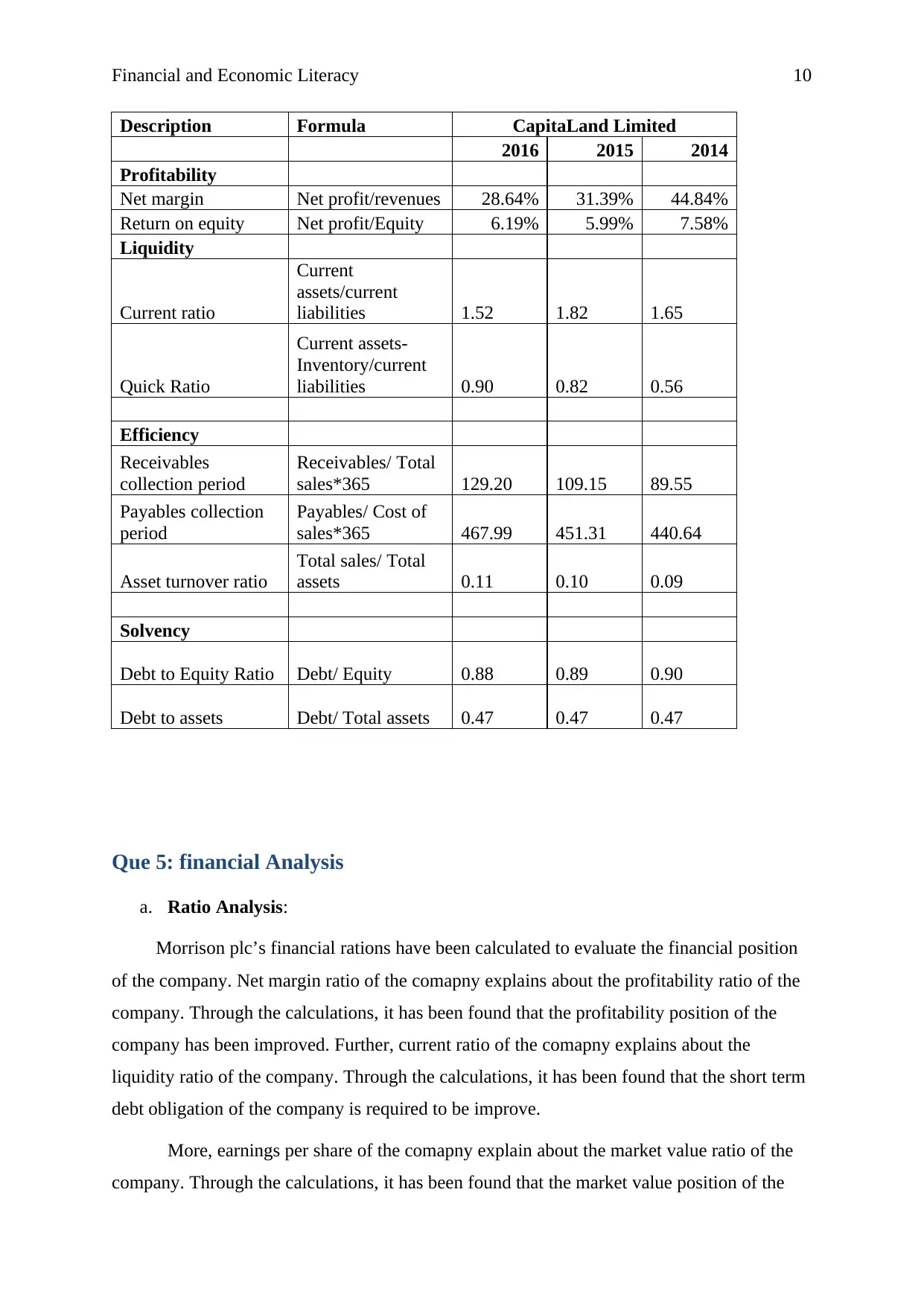
Financial and Economic Literacy 10
Description Formula CapitaLand Limited
2016 2015 2014
Profitability
Net margin Net profit/revenues 28.64% 31.39% 44.84%
Return on equity Net profit/Equity 6.19% 5.99% 7.58%
Liquidity
Current ratio
Current
assets/current
liabilities 1.52 1.82 1.65
Quick Ratio
Current assets-
Inventory/current
liabilities 0.90 0.82 0.56
Efficiency
Receivables
collection period
Receivables/ Total
sales*365 129.20 109.15 89.55
Payables collection
period
Payables/ Cost of
sales*365 467.99 451.31 440.64
Asset turnover ratio
Total sales/ Total
assets 0.11 0.10 0.09
Solvency
Debt to Equity Ratio Debt/ Equity 0.88 0.89 0.90
Debt to assets Debt/ Total assets 0.47 0.47 0.47
Que 5: financial Analysis
a. Ratio Analysis:
Morrison plc’s financial rations have been calculated to evaluate the financial position
of the company. Net margin ratio of the comapny explains about the profitability ratio of the
company. Through the calculations, it has been found that the profitability position of the
company has been improved. Further, current ratio of the comapny explains about the
liquidity ratio of the company. Through the calculations, it has been found that the short term
debt obligation of the company is required to be improve.
More, earnings per share of the comapny explain about the market value ratio of the
company. Through the calculations, it has been found that the market value position of the
Description Formula CapitaLand Limited
2016 2015 2014
Profitability
Net margin Net profit/revenues 28.64% 31.39% 44.84%
Return on equity Net profit/Equity 6.19% 5.99% 7.58%
Liquidity
Current ratio
Current
assets/current
liabilities 1.52 1.82 1.65
Quick Ratio
Current assets-
Inventory/current
liabilities 0.90 0.82 0.56
Efficiency
Receivables
collection period
Receivables/ Total
sales*365 129.20 109.15 89.55
Payables collection
period
Payables/ Cost of
sales*365 467.99 451.31 440.64
Asset turnover ratio
Total sales/ Total
assets 0.11 0.10 0.09
Solvency
Debt to Equity Ratio Debt/ Equity 0.88 0.89 0.90
Debt to assets Debt/ Total assets 0.47 0.47 0.47
Que 5: financial Analysis
a. Ratio Analysis:
Morrison plc’s financial rations have been calculated to evaluate the financial position
of the company. Net margin ratio of the comapny explains about the profitability ratio of the
company. Through the calculations, it has been found that the profitability position of the
company has been improved. Further, current ratio of the comapny explains about the
liquidity ratio of the company. Through the calculations, it has been found that the short term
debt obligation of the company is required to be improve.
More, earnings per share of the comapny explain about the market value ratio of the
company. Through the calculations, it has been found that the market value position of the
Paraphrase This Document
Need a fresh take? Get an instant paraphrase of this document with our AI Paraphraser
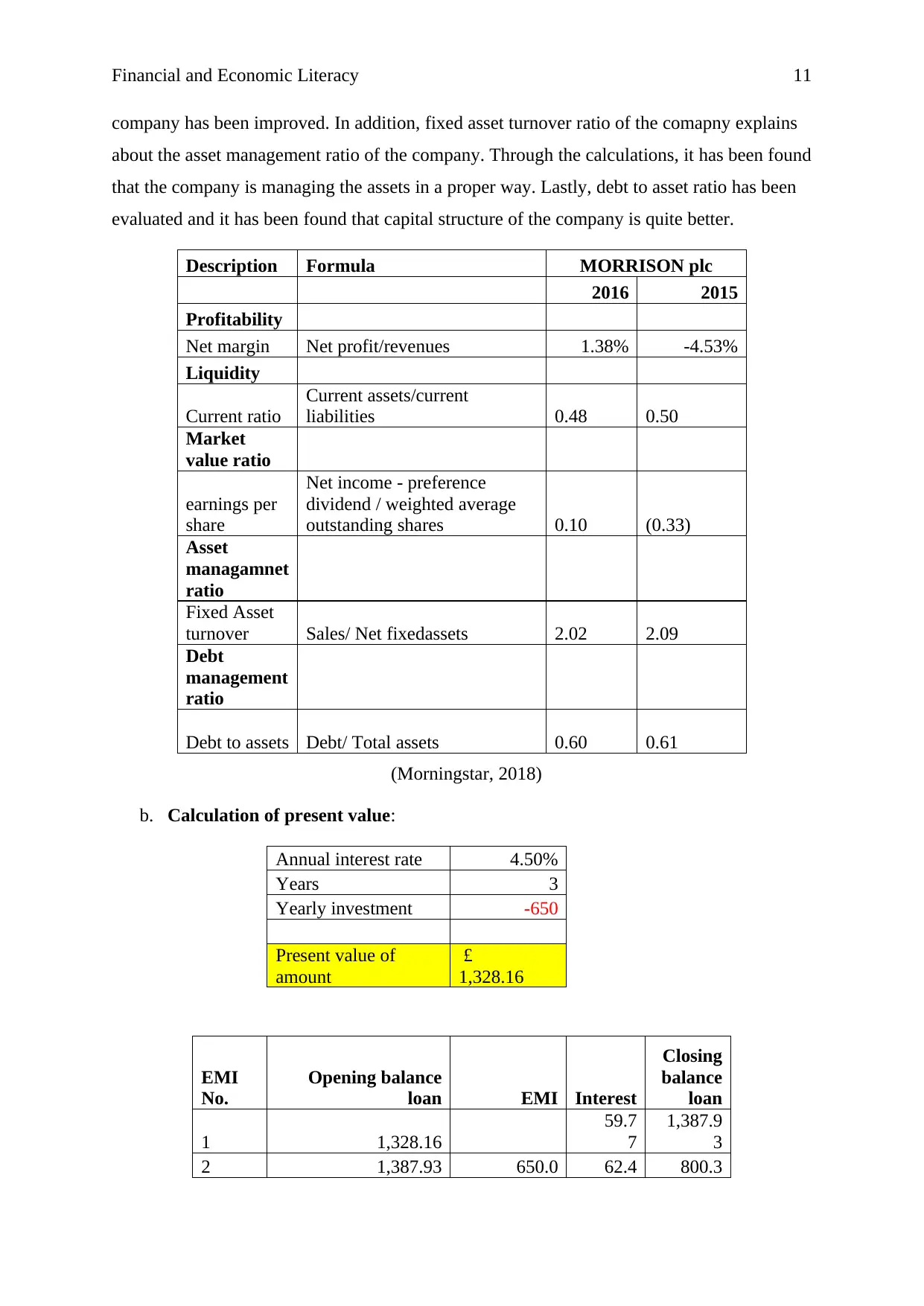
Financial and Economic Literacy 11
company has been improved. In addition, fixed asset turnover ratio of the comapny explains
about the asset management ratio of the company. Through the calculations, it has been found
that the company is managing the assets in a proper way. Lastly, debt to asset ratio has been
evaluated and it has been found that capital structure of the company is quite better.
Description Formula MORRISON plc
2016 2015
Profitability
Net margin Net profit/revenues 1.38% -4.53%
Liquidity
Current ratio
Current assets/current
liabilities 0.48 0.50
Market
value ratio
earnings per
share
Net income - preference
dividend / weighted average
outstanding shares 0.10 (0.33)
Asset
managamnet
ratio
Fixed Asset
turnover Sales/ Net fixedassets 2.02 2.09
Debt
management
ratio
Debt to assets Debt/ Total assets 0.60 0.61
(Morningstar, 2018)
b. Calculation of present value:
Annual interest rate 4.50%
Years 3
Yearly investment -650
Present value of
amount
£
1,328.16
EMI
No.
Opening balance
loan EMI Interest
Closing
balance
loan
1 1,328.16
59.7
7
1,387.9
3
2 1,387.93 650.0 62.4 800.3
company has been improved. In addition, fixed asset turnover ratio of the comapny explains
about the asset management ratio of the company. Through the calculations, it has been found
that the company is managing the assets in a proper way. Lastly, debt to asset ratio has been
evaluated and it has been found that capital structure of the company is quite better.
Description Formula MORRISON plc
2016 2015
Profitability
Net margin Net profit/revenues 1.38% -4.53%
Liquidity
Current ratio
Current assets/current
liabilities 0.48 0.50
Market
value ratio
earnings per
share
Net income - preference
dividend / weighted average
outstanding shares 0.10 (0.33)
Asset
managamnet
ratio
Fixed Asset
turnover Sales/ Net fixedassets 2.02 2.09
Debt
management
ratio
Debt to assets Debt/ Total assets 0.60 0.61
(Morningstar, 2018)
b. Calculation of present value:
Annual interest rate 4.50%
Years 3
Yearly investment -650
Present value of
amount
£
1,328.16
EMI
No.
Opening balance
loan EMI Interest
Closing
balance
loan
1 1,328.16
59.7
7
1,387.9
3
2 1,387.93 650.0 62.4 800.3
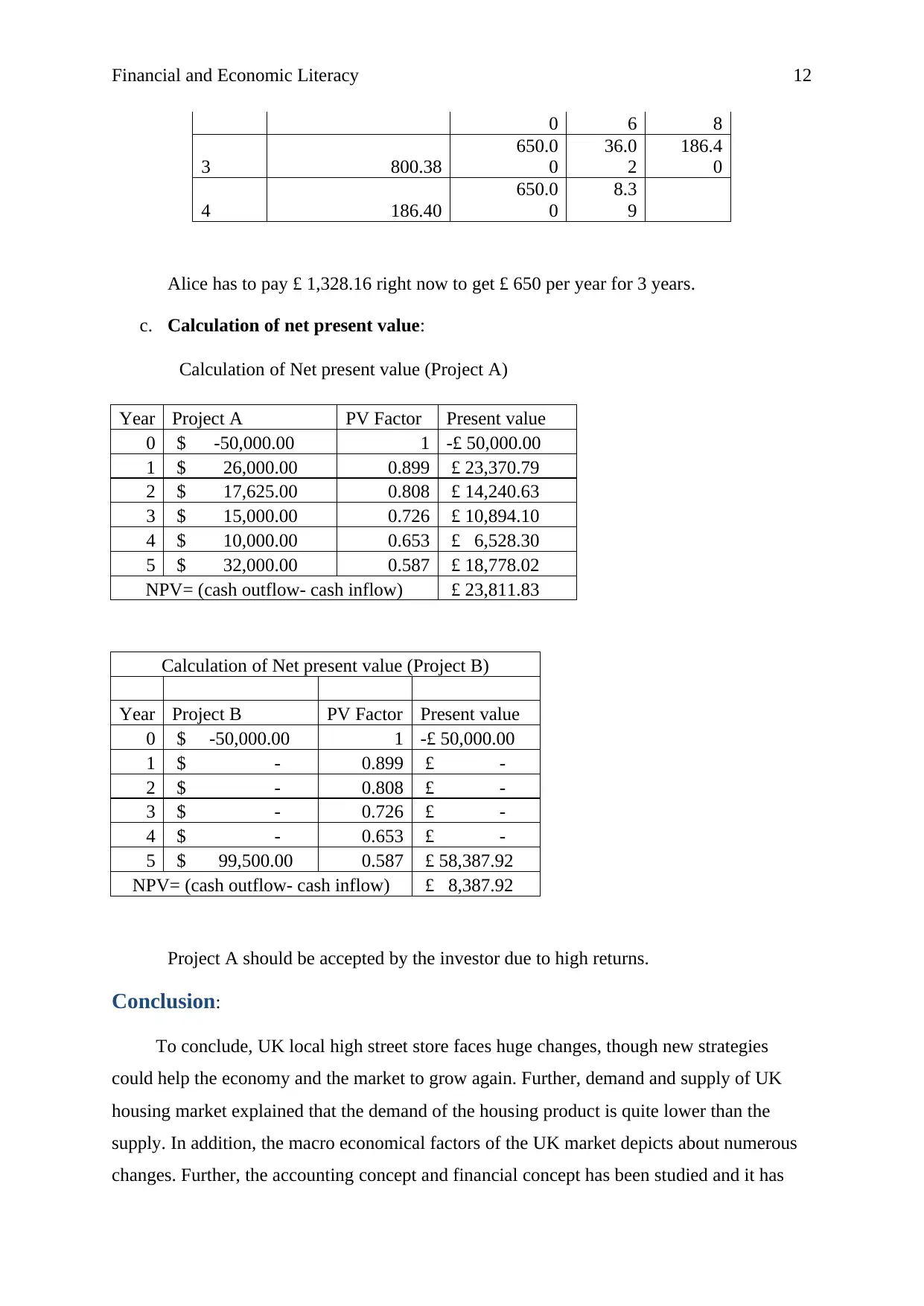
Financial and Economic Literacy 12
0 6 8
3 800.38
650.0
0
36.0
2
186.4
0
4 186.40
650.0
0
8.3
9
Alice has to pay £ 1,328.16 right now to get £ 650 per year for 3 years.
c. Calculation of net present value:
Calculation of Net present value (Project A)
Year Project A PV Factor Present value
0 $ -50,000.00 1 -£ 50,000.00
1 $ 26,000.00 0.899 £ 23,370.79
2 $ 17,625.00 0.808 £ 14,240.63
3 $ 15,000.00 0.726 £ 10,894.10
4 $ 10,000.00 0.653 £ 6,528.30
5 $ 32,000.00 0.587 £ 18,778.02
NPV= (cash outflow- cash inflow) £ 23,811.83
Calculation of Net present value (Project B)
Year Project B PV Factor Present value
0 $ -50,000.00 1 -£ 50,000.00
1 $ - 0.899 £ -
2 $ - 0.808 £ -
3 $ - 0.726 £ -
4 $ - 0.653 £ -
5 $ 99,500.00 0.587 £ 58,387.92
NPV= (cash outflow- cash inflow) £ 8,387.92
Project A should be accepted by the investor due to high returns.
Conclusion:
To conclude, UK local high street store faces huge changes, though new strategies
could help the economy and the market to grow again. Further, demand and supply of UK
housing market explained that the demand of the housing product is quite lower than the
supply. In addition, the macro economical factors of the UK market depicts about numerous
changes. Further, the accounting concept and financial concept has been studied and it has
0 6 8
3 800.38
650.0
0
36.0
2
186.4
0
4 186.40
650.0
0
8.3
9
Alice has to pay £ 1,328.16 right now to get £ 650 per year for 3 years.
c. Calculation of net present value:
Calculation of Net present value (Project A)
Year Project A PV Factor Present value
0 $ -50,000.00 1 -£ 50,000.00
1 $ 26,000.00 0.899 £ 23,370.79
2 $ 17,625.00 0.808 £ 14,240.63
3 $ 15,000.00 0.726 £ 10,894.10
4 $ 10,000.00 0.653 £ 6,528.30
5 $ 32,000.00 0.587 £ 18,778.02
NPV= (cash outflow- cash inflow) £ 23,811.83
Calculation of Net present value (Project B)
Year Project B PV Factor Present value
0 $ -50,000.00 1 -£ 50,000.00
1 $ - 0.899 £ -
2 $ - 0.808 £ -
3 $ - 0.726 £ -
4 $ - 0.653 £ -
5 $ 99,500.00 0.587 £ 58,387.92
NPV= (cash outflow- cash inflow) £ 8,387.92
Project A should be accepted by the investor due to high returns.
Conclusion:
To conclude, UK local high street store faces huge changes, though new strategies
could help the economy and the market to grow again. Further, demand and supply of UK
housing market explained that the demand of the housing product is quite lower than the
supply. In addition, the macro economical factors of the UK market depicts about numerous
changes. Further, the accounting concept and financial concept has been studied and it has
⊘ This is a preview!⊘
Do you want full access?
Subscribe today to unlock all pages.

Trusted by 1+ million students worldwide
1 out of 19
Related Documents
Your All-in-One AI-Powered Toolkit for Academic Success.
+13062052269
info@desklib.com
Available 24*7 on WhatsApp / Email
![[object Object]](/_next/static/media/star-bottom.7253800d.svg)
Unlock your academic potential
Copyright © 2020–2025 A2Z Services. All Rights Reserved. Developed and managed by ZUCOL.





